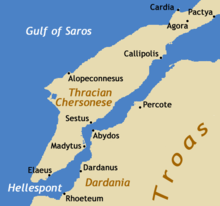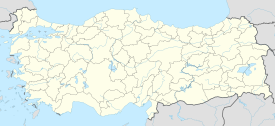Sestos
This article needs additional citations for verification. (January 2009) |
Σηστός | |
 Sestos and the Hellespont | |
| Location | Bigalı, Çanakkale Province, Turkey |
|---|---|
| Region | Thracian Chersonese |
| Type | Settlement |
Sestos (Template:Lang-el) or Sestus was an ancient Greek town of the Thracian Chersonese,[1] the modern Gallipoli peninsula in European Turkey. Situated on the Hellespont opposite Abydos, it was the home of Hero in the legend of Hero and Leander, where according to legend she lived in a tower overlooking the sea. Sestos was an Aeolian colony, as it was founded by settlers from Lesbos. The ruins of the town are near to the modern settlement of Eceabat.
In 480 BC, Xerxes' army crossed at this point on two temporary pontoon bridges later known as Xerxes' Pontoon Bridges, and most of Alexander the Great's forces went the other way here by boat in 334 BC.
In 1810 Lord Byron swam from Sestos to Abydos in four hours, recreating Leander's feat, and wrote a poem thereafter.[2] This event is commemorated every year with an annual swim event that recreates the crossing.[3]
Little now remains of the ancient town of Sestos.

Hero and Leander
Sestos is central to Christopher Marlowe's poem Hero and Leander, and is referred to in its opening lines:
On Hellespont, guilty of true love's blood,
In view and opposite two cities stood,
Sea-borderers, disjoin'd by Neptune's might:
The one Abydos, the other Sestos hight.
At Sestos Hero dwelt; Hero the fair,
Whom young Apollo courted for her hair.
The poem's two parts are called "Sestiads".
The Siege of Sestos
In 479BC-478BC, after the Greek victories (against Persia) at Plataea and Mycale, Greek forces under the command of Xanthippus besieged the Persian forces. The Athenians attacked the Persian forces, and defeated the Persians. Since the Persians were defeated, the Persian garrison at Sestos allowed the Greeks to conquer the city. As a result, Persian influence along the Hellespont was significantly reduced. This served the dual goal of denying Persian land forces access to the Greek mainland, while restoring Athenian trade to Black Sea ports such as Byzantium.
References
- Ancient Greek archaeological sites in Turkey
- Greek colonies in Thrace
- Aeolian colonies
- Battles of the Greco-Persian Wars
- Battles involving the Achaemenid Empire
- 479 BC
- Former populated places in Turkey
- Geography of Çanakkale Province
- History of Çanakkale Province
- Visitor attractions in Çanakkale Province
- Gallipoli Peninsula
- Members of the Delian League
- Çanakkale Province geography stubs
- Ancient Greece stubs

